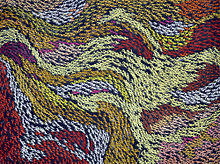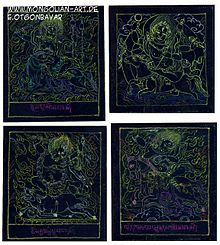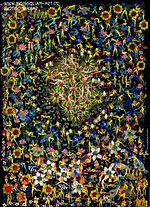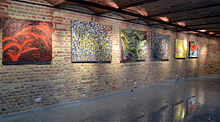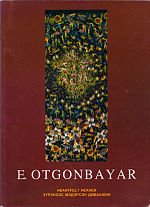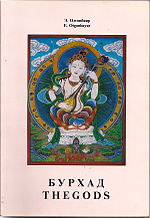- Otgonbayar Ershuu
-
Otgonbayar Ershuu (Mongolian: Эршүүгийн Отгонбаяр; * 18. January 1981 in Ulan Bator) is a Mongolian painter. His artist name is OTGO.
Contents
Life
He grew up among seven siblings and one adoptive brother and was fascinated by painting ever since his childhood. His talent was discovered and by the age of 15 years he had his own solo exhibitions. Ershuu studied traditional Mongolian Painting in Ulan Bator in 1998. During his academic studies he created around 400 pictures. After his studies he participated in several expeditions to historical sites in Mongolia as a painter and conservator. Ershuu studied the different techniques and iconography of the miniature paintings as well as their spiritual backgrounds at the Buddhist-lamaist monasteries. He has been active as a free lance artist since 1998. In addition to his free artistic works he has created around 600 "research images." Ershuu has been living in Berlin since 2005. From 2007 to 2010 he studied at the Institute for Art in Context, Faculty of Fine Arts, Berlin University of the Arts and graduated with a Masters of Arts in 2010. Otgonbayar Ershuu has been exhibiting his work in international exhibitions in Japan, Sweden, France, the Netherlands, India, Czech Republic, Switzerland, Germany and Mongolia.
Art
Thangka painting
OTGO's Thangkas have not evolved from religious intentions but were rather inspired by the challenge to learn such a demanding as well as traditional technique. A deep fascination with the technology of producing such a work of art as well as his own anticipation of an individual artistic implementation in the face of strict regulations, incited the artist's ambitions and posed the beginning of a longtime development in the field of Thangka painting. OTGO developed his painting techniques on long journeys through Mongolia. These could be described as a potpourri of experience, endurance and incredible artistic talent. One of OTGO's unique characteristics is to paint his depictions directly on the canvas thereby evading the process of sketching. After considering that his pictures are only slightly bigger than a slide one perceives clearly how detailed, precise and perfect the painter has to work in order to create such a picture. Otgonbayar Ershuu has created 600 Thangkas of which the majority of the pictures were created in a single attempt. Each streak can only be commenced once and it is barely impossible to correct any mistakes. States of utter concentration need to be maintained despite natural human needs or unpredictable distractions. Mongolian Thangka painting has been miniaturized according to the tradition of its country and even the iconography has been adapted to the diverse existing beliefs. OTGO's repertoire of figures draws on the theotechny of Shamanism, of Tengerism and Buddhism. Remarkable is also his depiction of mostly erotic themes. One of the principles of the Mongolian belief is the achievement of the "unity of all" by overcoming all antagonisms perceptible in the world of reality. Emblematic of this is the sexual union of man and woman, which bears the seed of a new life. It follows in considering this principal thought that the eroticization of the religious content of images becomes a natural and almost self-evident consequence. Otgonbayar Ershuu takes his topics and divine figures from traditional artistic depictions. His miniature gods are partially details of bigger paintings or pictorial interpretations of a sculpture. They are however always individualized in his unique, very special mode and have developed into real "OTGO's." During the production of his Thangkas Otgonbayar Ershuu uses different primers. In order to obtain these it is necessary to pre-treat his canvases. The black primer is a mixtures of carbon black, chalk, and vodka or milk liquor. He adds to this a mixture of pigments, minerals and plants. Finally the mixture is bound with glue extracted from yak hide and applied to both sides of the canvas. Even after ten years a "smelling test" regarding these small pictures will reveal the use of carbon black and alcohol to pre-treat the canvas and endows these miniature works of art with a mysterious and antique nature.
Miniature painting
It is absolutely remarkable in which precise and loving detail Otgonbayar Ershuu fills his canvases. Lively, colorful depictions of paradise, erotica and flocks of horses mesmerize his pictorial surfaces into imaginative compositions, capture and challenge to explore the world of miniature paintings. Otgonbayar Ershuu has created detailed paintings in breathtaking filigree in tempera on canvas. His newest works present a whole new world of creation. The young artist composed a fascinating coexistence of detailed miniature painting and active abstraction of picture elements in acrylic on canvas.
Comic
One of the longtime works of Otgonbayar Ershuu has been his "Secret History of the Mongols – related in the style of Mongolian painting as a comic." This comic consists of about 600 pages, which are divided into 12 chapters. Each page features several pictures amounting to a work of about altogether 3000 drawings. The "Secret History of the Mongols" was written about 800 years ago and is considered the oldest and most significant Mongolian work of literature – as myth, epos and chronic all at once. It did not contain any illustrations originally. In order to make this history more comprehensive and interesting for all ages, Ershuu decided to transform the content of this significant work into Mongolian miniature painting. The idea emerged from his belief that the viewing of images is often easier than reading. One of his main concerns during the development of the comic was to portray ethnic features of the Mongols as well as historical facts and artifacts as precisely and genuine as possible. Therefore he had to pursue extensive researches which lead him into various academic areas. By including miniature painting in his work he intended to capture something characteristically and traditionally Mongolian.
Gallery ZURAG
Gallery ZURAG, founded in 2010 by Otgonbayar Ershuu is located in the middle of Berlin, one of the world's most vibrant art capitals. It is the first gallery founded and operated by a Mongol outside of Mongolia.
Movies
- ZURAG – a movie about Otgonbayar Ershuu; Germany/Mongolia 2010; produced by Tobias Wulff (The movie was broadcasted twice in the Mongolian State television in 2011)
- ZURAG movie online, languages: German and Mongolian
Publications
- Otgonbayar Ershuu: HEARTFELT HEAVEN. Printed in Hiimori Printing Co., Ltd Ulan Bator Mongolia 2004, ISBN 99929-74-08-7
- Otgonbayar Ershuu: THE GODS Printed in Hiimori Printing Co., Ltd Ulan Bator Mongolia 2004, ISBN 99929-74-07-9
Awards
- 1996: Awarded with the gold medal "Knowledge" by the culture palace of Mongolian Children institution, Ulan Bator
- 2004: Awarded as "Best Mongolian National Talent" by the Ministry of Education, Culture and Science of Mongolia
Critiques
- From time to time his art tilts towards the almost grotesque, as if the picture was so full of humans that they start to devour each other. Whole armies disappear into the mouth of another human; masses of humans wriggle closely around each other and it may either be associated with overpopulation or a perishing global orgy.
(Åsa Jonsén newspaper review „Nerikes Allehanda“ 11/17/2007 (Örebro, Sweden) (Translation by Elisa Kohl-Carrity)
- Through his studies OTGO has brought miniature painting to new heights. In modifying his position in regard to the picture the onlooker discovers the picture-in-picture composition as if looking through an artistically arranged prismatic telescope, which reveals detailed sceneries with completely independent meanings with every approaching step. This obfuscates the painting's overall impression of the playful handling of colors and motifs and the peaceful coexistence of stencil-like precise, seemingly light and cheerful elements which may only be perceived from a distance. With each step towards the picture the onlooker discovers a new and diverse aspect of its interiority.
(Uwe Ahnert, gallery owner, Collection Freudenberg, Berlin 2009) (Translation by Elisa Kohl-Carrity)
- Minimundus explains the world to us OTGO will explain Mongolia – Land of the horses - to us. Who else could do it, who else painted half a million horses? (Martina Busch, Berlin 2010) (Translation by Elisa Kohl-Carrity)
Solo exhibitions
- "HOS YUS" Exhibition in the culture palace of the Mongolian Children in Ulan Bator, Mongolia (1996)
- "GODS" Exhibition at the Adelhauser museum in Freiburg, Germany (2007)
- "MONGOLIAN MINIATURE PAINTING" Exhibition at the Mongolia Center in Freiburg, Germany (2007)
- "MINIATURE PAINTING" Exhibition at the Deutsche Bank in Berlin, Germany (2007)
- "Paradise felt with my heart" Exhibition in Munich, Germany (2007)
- "OTGO IN ÖREBRO" Exhibition in the Konstfrämjandet gallery Örebro, Sweden (2007)
- "OTGO IN THE PALACE" Exhibition in Örebro, Sweden (2009)
- "OTGO IN THE PALACE SEEHEIM" Exhibition Konstanz, Germany (2009)
- "THUNDERING HOOVES" Exhibition at the ZURAG gallery in Berlin, Germany (2011)
- "THUNDERING HOOVES" Exhibition in Bonn, Germany (2011)
- "GODS" Exhibition at the ZURAG gallery in Berlin, Germany (2011)
- "MONGOL AYAN – 1" Exhibition in Elsass, France (2011)
- "MONGOL AYAN – 4" Exhibition at the Fischer-Art studio in Leipzig, Germany (2011)
External links
- Otgonbayar Ershuu's web site (German)(English)(Mongolian)
- Portrait on the MongoliaOnline portal
Categories:- 1981 births
- Mongolian people
- Mongolian painters
- Portrait artists
- Modern artists
- Modern painters
- Living people
Wikimedia Foundation. 2010.


